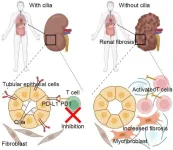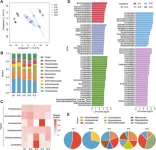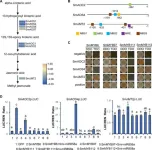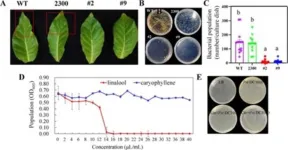(Press-News.org) A new study from deCODE genetics uses pedigrees and sequence data from 64,806 Icelanders to shed light on the rate and nature of mutations in mitochondrial DNA (mtDNA) and the peculiar dynamics of its maternal transmission.
In a paper published today in Cell, scientists from deCODE genetics, a subsidiary of Amgen, present the largest study to date of germline mtDNA mutations in humans and their transmission across 116,663 mother-child pairs. The study documents the astonishing extent of hypermutability at some positions in mtDNA, including the well-known deleterious A>G mutation at position 3243 which causes the MELAS syndrome. The mutation occurred 15 times in the 2,548 matrilineal pedigrees, but typically disappeared after several generations, due to its severe impact on the health of carriers.
Strong aggregate evidence was uncovered for selection against many such short-lived deleterious mtDNA mutations in the pedigrees. The deCODE team also reported evidence for an extensive earlier episode of negative selection affecting mitochondria, called germline selection, where poorly functioning mitochondrial DNA molecules are discarded during the development of oocytes. Finally, they used the large number of transmissisons of mtDNA mutations in the pedigrees to reliably estimate that individuals inherit, on average, only around 3 units of mtDNA from their mothers – fewer than indicated by previous studies.
„It is remarkable that the hundreds of thousands of mtDNA carried by oocytes are derived from only about three of the mtDNA molecules originally carried by the mother,” noted Agnar Helgason, a corresponding author of the paper. „This drastic bottleneck determines the rapid rate at which new mutations in the mtDNA germline can become lost or fixed over just a handful of generations in a pedigree, and must be in part due to a selection process during the development of oocytes, where mtDNA molecules with deleterious mutations are removed from the germline.“
„This study takes us a few steps closer to understanding the basis of the extraordinary variation in mutation rates across the nucelotides of the mtDNA genome, even between different alleles at the same position“, said Kári Stefánsson, CEO of deCODE and a corresponding author of the paper. „Unfortunately, it is the hypermutability of some pathogenic mutations that has made them so prevalent and thereby easier to discover. However, our findings suggest that many rarer pathogenic mtDNA mutations that are responsible for disease burden in human populations remain to be discovered.“
Background information
A small but important part of the human genome is found in mitochondria, cellular organelles that provide the energy that fuels many of the essential chemical reactions in cells. Mitochondrial DNA (mtDNA) is passed down only from mothers, via the oocyte (egg cell) that gives rise to each individual. Each individual starts with hundreds of thousands of copies of mtDNA, derived from a small subset of the original mtDNA molecules carried by the mother – through a filtering mechanism known as the „germline bottleneck“ when oocytes are produced. When a sizeable proportion of the mtDNA copies transmitted from mother to child carry a deleterious mutation, the result is typically a particular combination of serious diseases, including stroke, type 2 diabetes, myopathies, blindness and deafness. Around 1 in every 5000 individuals are affected by diseases due to known deleterious mtDNA mutations. However, there are many more mutations whose deleterious impact has yet to be determined, leading to an expectation of an even greater disease burden due to mtDNA mutations. Previous phylogenetic studies have shown that the germline mutation rate of mtDNA is around 20 times higher than that of the autosomal chromosomes. However, since such studies underestimate the mtDNA mutation rate, particularly for delerious variants, a large study of mtDNA mutations in genealogies was needed to gain a more comprehensive understanding of their rate and nature and impact on human health.
The deCODE study used sequence data from 64,806 Icelanders, arranged into an extensive set of 2,548 matrilineal genealogies (matrilines), spanning 116,663 mother-child transmissions of mtDNA, to detect 8,199 mutations. The largest matriline contained 2,056 transmissions, linking 1,051 sequenced individuals traced back to an ancestor born around 1520. The mutation rate estimates are 2.87×10-6 and 2.38×10-5 mutations per position per generation for the coding and control regions of mtDNA, respectively, around 5 times greater than previous phylogenetic estimates. A key novelty leading from such an extensive set of mtDNA mutations identified in matrilines is the possibility of distinguishing between two kinds of selection against deleterious mutations. First, by comparing them with mutations ascertained from a phylogeny, they were able to assess the strength of selection that removes deleterious, but viable variants from populations over many generations. Evidence of hypermutability was observed for some well-known deleterious mtDNA mutations, including the A>G mutation at position 3243, which occurred 15 times in the matrilines, but typically disappears after several generations, due to its severe impact on the health of carriers. Second, there was strong evidence for extensive negative selection that occurs before individuals are conceived or born, thereby affecting the kinds of mutations that can be detected in live-born humans. The most likely mechanism is germline selection, whereby poorly functioning mitochondrial DNA molecules are discarded during the development of oocytes. This would reduce the size of the germline bottleneck, that determines the number of mtDNA molecules transmitted from mothers to offspring during the development of oocytes. Indeed, using the large number of transmissisons of mtDNA mutations in the Icelandic matrilines, the deCODE team were able to reliably estimate that individuals inherit, on average, only around 3 units of mtDNA from their mothers.
END
The rate, nature and transmission of mitochondrial DNA mutations in humans
A new study from deCODE genetics uses pedigrees and sequence data from 64,806 Icelanders to shed light on the rate and nature of mutations in mitochondrial DNA (mtDNA) and the peculiar dynamics of its maternal transmission
2024-06-07
ELSE PRESS RELEASES FROM THIS DATE:
Prevalence of iron deficiency using 3 definitions among women in the US and Canada
2024-06-07
About The Study: Three definitions of iron deficiency were associated with significantly different prevalence of iron deficiency in women, regardless of self-reported age, pregnancy, or race and ethnicity. Using higher serum ferritin thresholds to define iron deficiency could lead to diagnosis and treatment of more women with iron deficiency and greater reduction of related morbidity.
Corresponding Author: To contact the corresponding author, James C. Barton, M.D., email bartonjames336@gmail.com.
To access the embargoed study: ...
Bariatric metabolic surgery vs glucagon-like peptide-1 receptor agonists and mortality
2024-06-07
About The Study: Bariatric metabolic surgery was associated with greater reduced mortality compared with first-generation glucagon-like peptide-1 receptor agonists (GLP-1RAs) among individuals with a diabetes duration of 10 years or less, mediated via greater weight loss in this cohort study. No differences in the risk for mortality were observed between the treatment modalities among individuals with a longer duration of diabetes, nor in the occurrence of nonfatal major adverse cardiovascular events among all patients.
Corresponding Author: To contact the corresponding author, ...
Primary cilia restrict autoinflammation by mediating PD-L1 expression
2024-06-07
Ciliopathies are multisystem disorders characterized by the dysfunction of motile and/or non-motile cilia, which show common clinical manifestations of ciliopathies include retinal degeneration, mental retardation, renal abnormality, obesity, and skeletal dysplasia. Fibrosis of vital organs, characterized by the extensive deposition of extracellular matrix components, represents another complication frequently observed in patients and animal models of ciliopathies. However, the precise mechanism that connects ciliary defects to fibrosis remains largely elusive.
The recent study led by Dr. Min Liu (Haihe Laboratory of Cell Ecosystem) and Dr. Yunfan Yang (Shandong University) showed ...
Roots of resistance: unveiling the soil-saving secrets of grafting
2024-06-07
Grafting, an age-old horticultural technique, has been revealed as a powerful tool against soil-borne diseases like crown gall. New research uncovers how the composition of root exudates changes when plants are grafted onto resistant rootstocks, creating a defensive mechanism that reduces the prevalence of pathogenic Agrobacterium.
Crown gall disease, a destructive plant ailment caused by Agrobacterium, has long plagued agriculture, leading to significant crop losses. Traditional control methods have proven inadequate, highlighting an urgent need for innovative solutions. Given the pervasive impact of this disease and the limitations ...
Insilico Medicine Founder and CEO Alex Zhavoronkov, PhD talks about AI and robotics in healthcare breakthroughs in following conferences
2024-06-07
Alex Zhavoronkov, PhD, founder and co-CEO of Insilico Medicine (“Insilico”), a clinical-stage generative artificial intelligence (AI)-driven drug discovery company, will be attending a series of meetings in the following week, where he will be discussing bioscience innovations powered by AI and robotics.
More information about the events is listed as follows:
[1] London Tech Week 2024
Fireside Chat: The Forefront of AI Innovation in Health Tech
Time: Monday, 10th June 15:55 - 16:15 (UK time)
Location: London Olympia, Main Stage
London Tech Week is the global tech ecosystem aiming to accelerate the infinite cycle of tech innovation, which brings together the innovators ...
New: Classification Criteria for Hand OA
2024-06-07
Hand osteoarthritis mainly affects the distal interphalangeal, proximal interphalangeal, and thumb base joints,1 leading to joint pain, aching, and stiffness. Criteria developed by the American College of Rheumatology (ACR) in 1990 are useful, but they cannot distinguish between interphalangeal or thumb base disease, and this is important since these two phenotypes may require different treatment strategies.
To address this, EULAR and a team of leading experts in the field set out to develop new classification criteria sets that include radiographic features. Early phases of the project used observational data to identify self-reported, ...
Perturbations simplify the study of “super photons”
2024-06-07
Thousands of particles of light can merge into a type of “super photon” under suitable conditions. Physicists call such a state a photon Bose-Einstein condensate. Researchers at the University of Bonn have now shown that this exotic quantum state obeys a fundamental theorem of physics. This finding now allows one to measure properties of photon Bose-Einstein condensates which are usually difficult to access. The study has been published in the journal Nature Communications.
If many atoms are cooled to a very low temperature confined in a small volume, they can become indistinguishable and behave like a single “super particle.” Physicists also call this ...
Decoding salvia miltiorrhiza: a molecular approach to boosting bioactive compounds
2024-06-07
Salvia miltiorrhiza, known as Danshen, is widely used in traditional Chinese medicine for treating cardiovascular diseases, cancer, and Alzheimer's disease. The medicinal properties of Danshen are primarily attributed to its two major bioactive compounds: tanshinones and phenolic acids. Despite their importance, the genetic and regulatory mechanisms underlying their biosynthesis remain poorly understood. Based on these challenges, there is a pressing need for in-depth research to uncover the molecular pathways involved in the production of these ...
Digital babies created to improve infant healthcare
2024-06-07
Researchers at University of Galway have created digital babies to better understand infants’ health in their critical first 180 days of life.
The team created 360 advanced computer models that simulate the unique metabolic processes of each baby.
The digital babies are the first sex-specific computational whole-body models representing newborn and infant metabolism with 26 organs, six cell types, and more than 80,000 metabolic reactions.
Real-life data from 10,000 newborns, including sex, birth weight and metabolite concentrations, enabled the creation and validation ...
Lavender's secret: genetic regulator boosts plant health and fragrance output
2024-06-07
A groundbreaking study has identified a gene that plays a dual role in enhancing both the aromatic compounds and disease resistance in lavender plants. The research uncovers how the LaMYC7 gene positively regulates the biosynthesis of linalool and caryophyllene, key for lavender's scent and its resistance to common plant pathogens.
Plants face various environmental pressures, including biotic stressors like pathogens and abiotic stressors such as extreme temperatures. Among biotic stressors, Pseudomonas syringae significantly threatens plant health worldwide. Terpenoids, including linalool and caryophyllene, play crucial roles in plant ...
LAST 30 PRESS RELEASES:
Adding antibody treatment to chemo boosts outcomes for children with rare cancer
Germline pathogenic variants among women without a history of breast cancer
Tanning beds triple melanoma risk, potentially causing broad DNA damage
Unique bond identified as key to viral infection speed
Indoor tanning makes youthful skin much older on a genetic level
Mouse model sheds new light on the causes and potential solutions to human GI problems linked to muscular dystrophy
The Journal of Nuclear Medicine ahead-of-print tip sheet: December 12, 2025
Smarter tools for peering into the microscopic world
Applications open for funding to conduct research in the Kinsey Institute archives
Global measure underestimates the severity of food insecurity
Child survivors of critical illness are missing out on timely follow up care
Risk-based vs annual breast cancer screening / the WISDOM randomized clinical trial
University of Toronto launches Electric Vehicle Innovation Ontario to accelerate advanced EV technologies and build Canada’s innovation advantage
Early relapse predicts poor outcomes in aggressive blood cancer
American College of Lifestyle Medicine applauds two CMS models aligned with lifestyle medicine practice and reimbursement
Clinical trial finds cannabis use not a barrier to quitting nicotine vaping
Supplemental nutrition assistance program policies and food insecurity
Switching immune cells to “night mode” could limit damage after a heart attack, study suggests
URI-based Global RIghts Project report spotlights continued troubling trends in worldwide inhumane treatment
Neutrophils are less aggressive at night, explaining why nighttime heart attacks cause less damage than daytime events
Menopausal hormone therapy may not pose breast cancer risk for women with BRCA mutations
Mobile health tool may improve quality of life for adolescent and young adult breast cancer survivors
Acupuncture may help improve perceived breast cancer-related cognitive difficulties over usual care
Nerve block may reduce opioid use in infants undergoing cleft palate surgery
CRISPR primes goldenberry for fruit bowl fame
Mass General Brigham announces new AI company to accelerate clinical trial screening and patient recruitment
Fat tissue around the heart may contribute to greater heart injury after a heart attack
Jeonbuk National University researcher proposes a proposing a two-stage decision-making framework of lithium governance in Latin America
Chromatin accessibility maps reveal how stem cells drive myelodysplastic progression
Cartilaginous cells regulate growth and blood vessel formation in bones
[Press-News.org] The rate, nature and transmission of mitochondrial DNA mutations in humansA new study from deCODE genetics uses pedigrees and sequence data from 64,806 Icelanders to shed light on the rate and nature of mutations in mitochondrial DNA (mtDNA) and the peculiar dynamics of its maternal transmission









